An Analysis of Baddeley’s Working Memory Model and Memory Research
VerifiedAdded on 2023/04/21
|8
|2243
|442
Essay
AI Summary
This essay provides an in-depth analysis of Baddeley's Working Memory Model, highlighting its significant contribution to memory research and cognitive psychology. The essay begins by introducing the concept of working memory and its importance in daily activities and complex tasks. It then delves into the components of Baddeley's model, including the central executive, phonological loop, visuospatial sketchpad, and episodic buffer, explaining their functions and interactions. The central executive is identified as the most crucial component, controlling attention and allocating resources. The essay also discusses the phonological loop and visuospatial sketchpad as slave subsystems responsible for holding verbal and spatial information, respectively. The episodic buffer, the newest component, integrates information from various sources to create coherent experiences. The essay further addresses challenges and criticisms of the model, particularly regarding the modality-specific nature of serial order memory. It concludes by emphasizing the model's broader applicability to tasks such as problem-solving, comprehension, and reasoning, making it a valuable framework for understanding human memory and cognition. Desklib provides access to this essay and many other solved assignments for students.
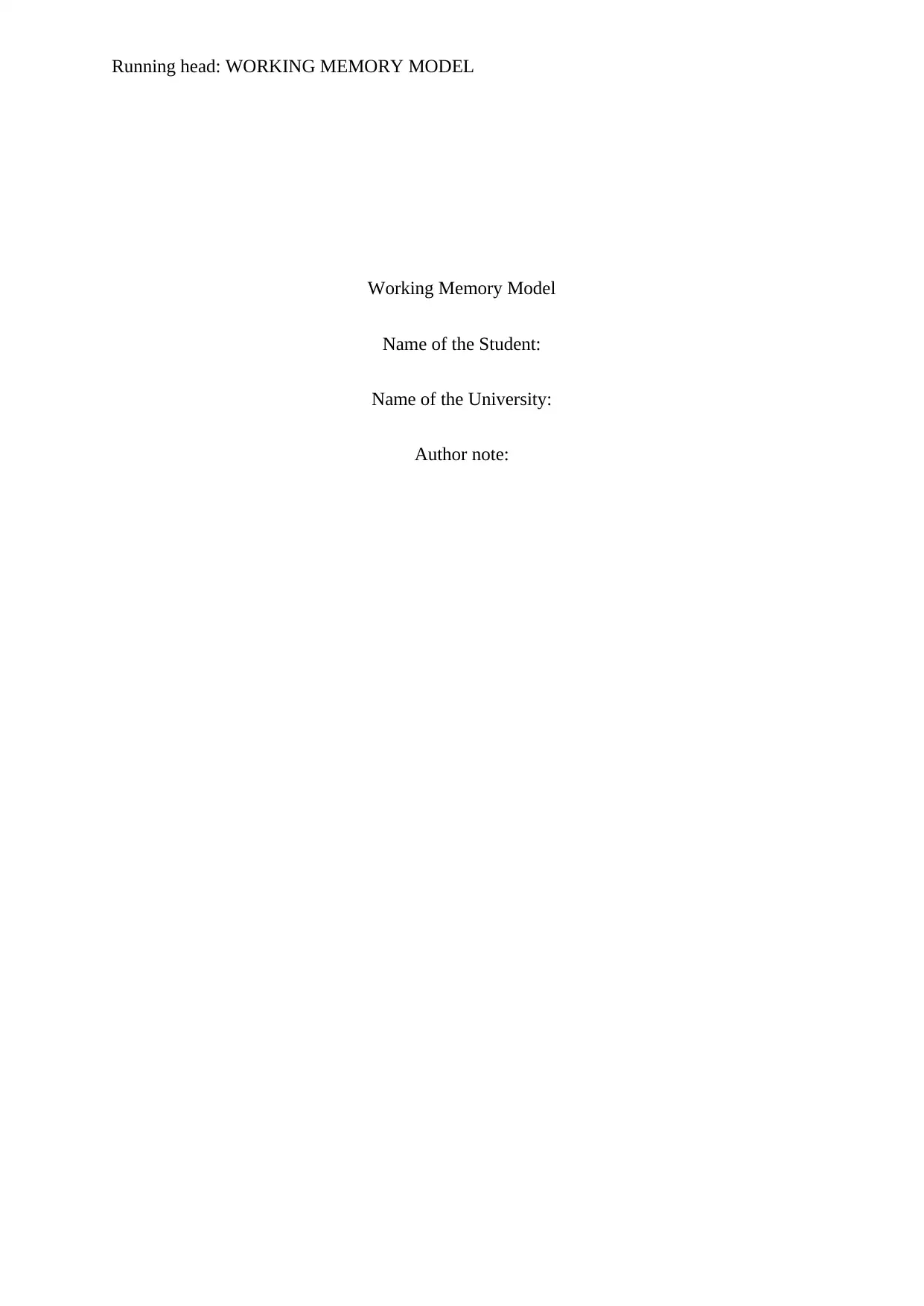
Running head: WORKING MEMORY MODEL
Working Memory Model
Name of the Student:
Name of the University:
Author note:
Working Memory Model
Name of the Student:
Name of the University:
Author note:
Paraphrase This Document
Need a fresh take? Get an instant paraphrase of this document with our AI Paraphraser
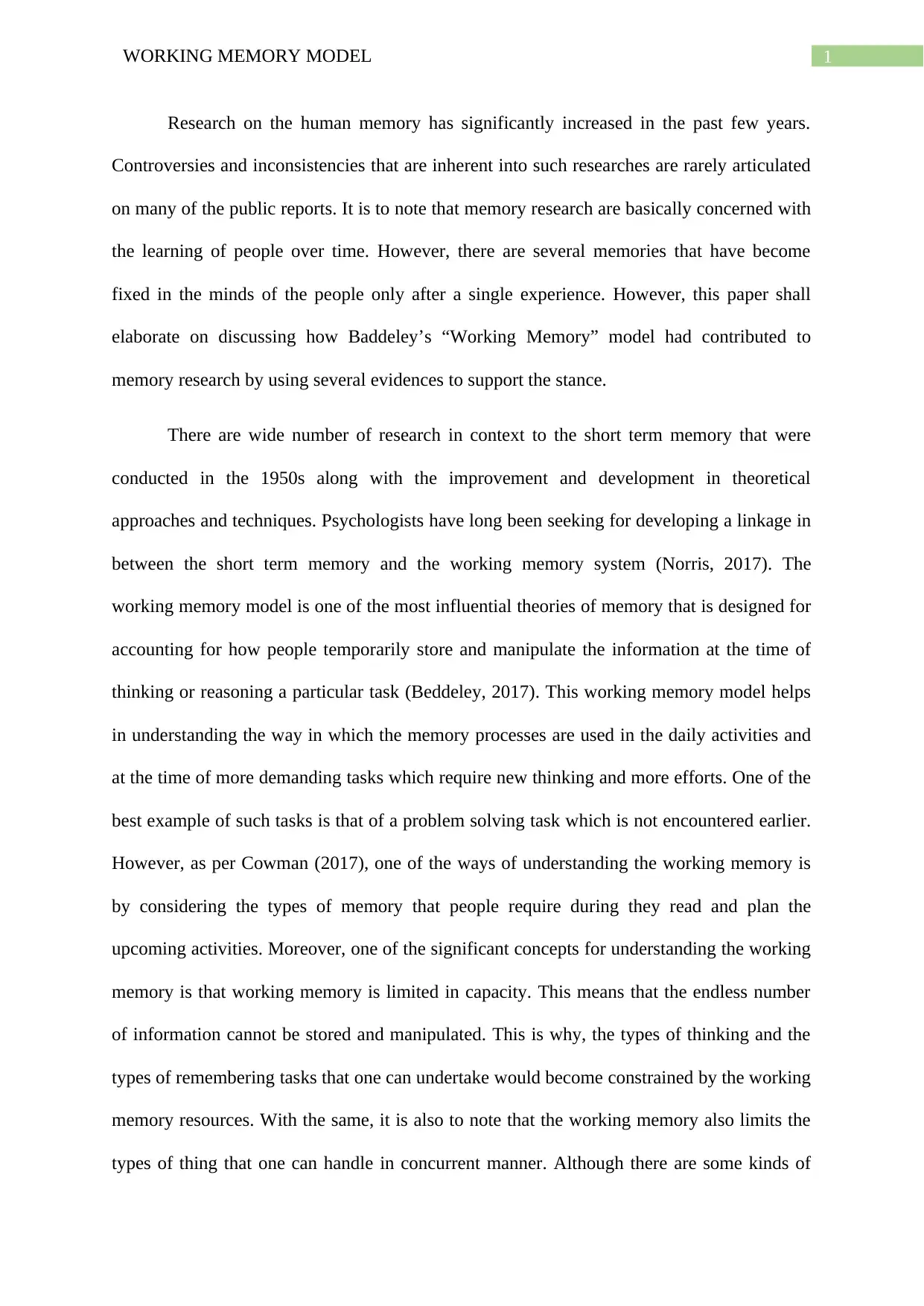
1WORKING MEMORY MODEL
Research on the human memory has significantly increased in the past few years.
Controversies and inconsistencies that are inherent into such researches are rarely articulated
on many of the public reports. It is to note that memory research are basically concerned with
the learning of people over time. However, there are several memories that have become
fixed in the minds of the people only after a single experience. However, this paper shall
elaborate on discussing how Baddeley’s “Working Memory” model had contributed to
memory research by using several evidences to support the stance.
There are wide number of research in context to the short term memory that were
conducted in the 1950s along with the improvement and development in theoretical
approaches and techniques. Psychologists have long been seeking for developing a linkage in
between the short term memory and the working memory system (Norris, 2017). The
working memory model is one of the most influential theories of memory that is designed for
accounting for how people temporarily store and manipulate the information at the time of
thinking or reasoning a particular task (Beddeley, 2017). This working memory model helps
in understanding the way in which the memory processes are used in the daily activities and
at the time of more demanding tasks which require new thinking and more efforts. One of the
best example of such tasks is that of a problem solving task which is not encountered earlier.
However, as per Cowman (2017), one of the ways of understanding the working memory is
by considering the types of memory that people require during they read and plan the
upcoming activities. Moreover, one of the significant concepts for understanding the working
memory is that working memory is limited in capacity. This means that the endless number
of information cannot be stored and manipulated. This is why, the types of thinking and the
types of remembering tasks that one can undertake would become constrained by the working
memory resources. With the same, it is also to note that the working memory also limits the
types of thing that one can handle in concurrent manner. Although there are some kinds of
Research on the human memory has significantly increased in the past few years.
Controversies and inconsistencies that are inherent into such researches are rarely articulated
on many of the public reports. It is to note that memory research are basically concerned with
the learning of people over time. However, there are several memories that have become
fixed in the minds of the people only after a single experience. However, this paper shall
elaborate on discussing how Baddeley’s “Working Memory” model had contributed to
memory research by using several evidences to support the stance.
There are wide number of research in context to the short term memory that were
conducted in the 1950s along with the improvement and development in theoretical
approaches and techniques. Psychologists have long been seeking for developing a linkage in
between the short term memory and the working memory system (Norris, 2017). The
working memory model is one of the most influential theories of memory that is designed for
accounting for how people temporarily store and manipulate the information at the time of
thinking or reasoning a particular task (Beddeley, 2017). This working memory model helps
in understanding the way in which the memory processes are used in the daily activities and
at the time of more demanding tasks which require new thinking and more efforts. One of the
best example of such tasks is that of a problem solving task which is not encountered earlier.
However, as per Cowman (2017), one of the ways of understanding the working memory is
by considering the types of memory that people require during they read and plan the
upcoming activities. Moreover, one of the significant concepts for understanding the working
memory is that working memory is limited in capacity. This means that the endless number
of information cannot be stored and manipulated. This is why, the types of thinking and the
types of remembering tasks that one can undertake would become constrained by the working
memory resources. With the same, it is also to note that the working memory also limits the
types of thing that one can handle in concurrent manner. Although there are some kinds of
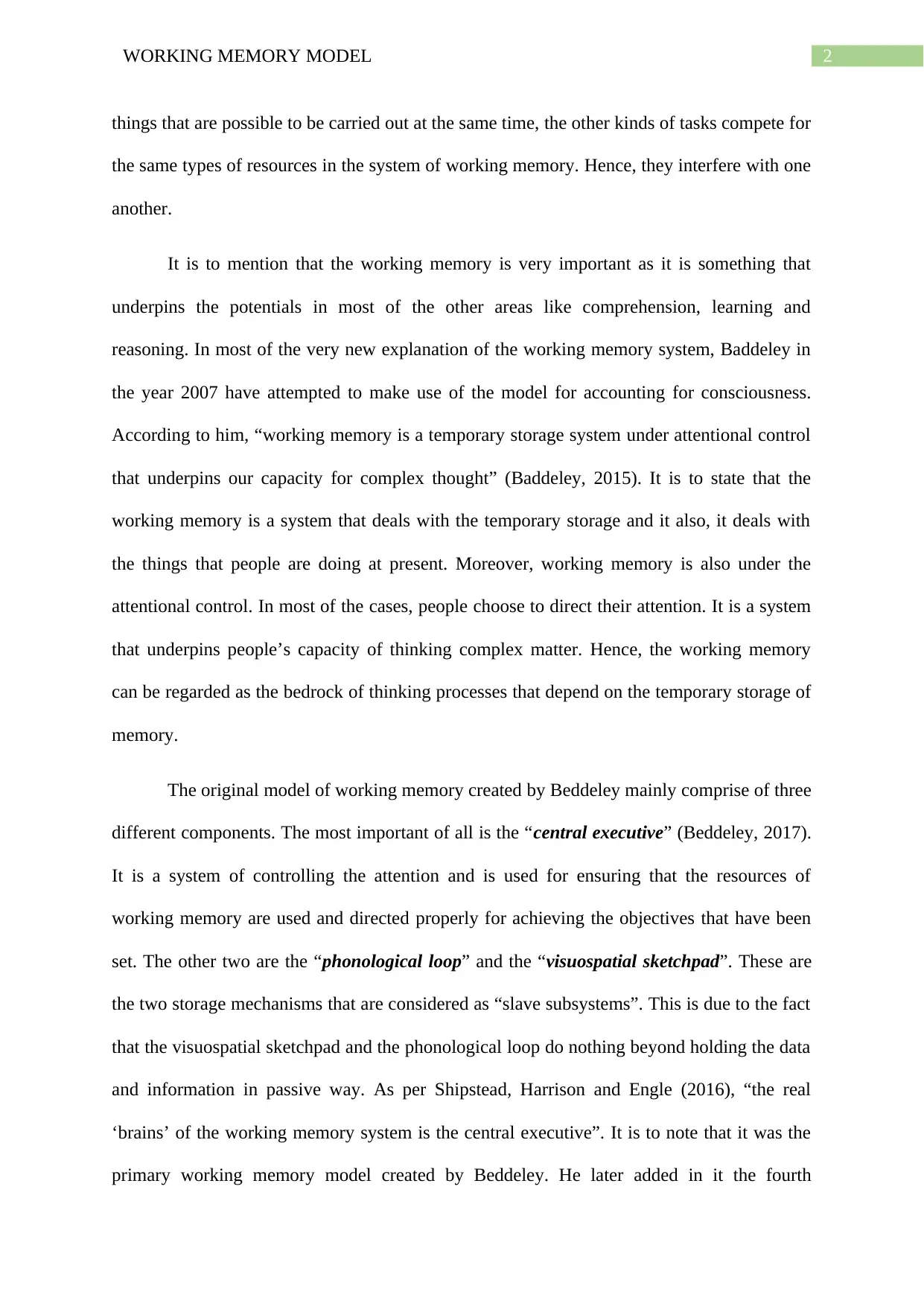
2WORKING MEMORY MODEL
things that are possible to be carried out at the same time, the other kinds of tasks compete for
the same types of resources in the system of working memory. Hence, they interfere with one
another.
It is to mention that the working memory is very important as it is something that
underpins the potentials in most of the other areas like comprehension, learning and
reasoning. In most of the very new explanation of the working memory system, Baddeley in
the year 2007 have attempted to make use of the model for accounting for consciousness.
According to him, “working memory is a temporary storage system under attentional control
that underpins our capacity for complex thought” (Baddeley, 2015). It is to state that the
working memory is a system that deals with the temporary storage and it also, it deals with
the things that people are doing at present. Moreover, working memory is also under the
attentional control. In most of the cases, people choose to direct their attention. It is a system
that underpins people’s capacity of thinking complex matter. Hence, the working memory
can be regarded as the bedrock of thinking processes that depend on the temporary storage of
memory.
The original model of working memory created by Beddeley mainly comprise of three
different components. The most important of all is the “central executive” (Beddeley, 2017).
It is a system of controlling the attention and is used for ensuring that the resources of
working memory are used and directed properly for achieving the objectives that have been
set. The other two are the “phonological loop” and the “visuospatial sketchpad”. These are
the two storage mechanisms that are considered as “slave subsystems”. This is due to the fact
that the visuospatial sketchpad and the phonological loop do nothing beyond holding the data
and information in passive way. As per Shipstead, Harrison and Engle (2016), “the real
‘brains’ of the working memory system is the central executive”. It is to note that it was the
primary working memory model created by Beddeley. He later added in it the fourth
things that are possible to be carried out at the same time, the other kinds of tasks compete for
the same types of resources in the system of working memory. Hence, they interfere with one
another.
It is to mention that the working memory is very important as it is something that
underpins the potentials in most of the other areas like comprehension, learning and
reasoning. In most of the very new explanation of the working memory system, Baddeley in
the year 2007 have attempted to make use of the model for accounting for consciousness.
According to him, “working memory is a temporary storage system under attentional control
that underpins our capacity for complex thought” (Baddeley, 2015). It is to state that the
working memory is a system that deals with the temporary storage and it also, it deals with
the things that people are doing at present. Moreover, working memory is also under the
attentional control. In most of the cases, people choose to direct their attention. It is a system
that underpins people’s capacity of thinking complex matter. Hence, the working memory
can be regarded as the bedrock of thinking processes that depend on the temporary storage of
memory.
The original model of working memory created by Beddeley mainly comprise of three
different components. The most important of all is the “central executive” (Beddeley, 2017).
It is a system of controlling the attention and is used for ensuring that the resources of
working memory are used and directed properly for achieving the objectives that have been
set. The other two are the “phonological loop” and the “visuospatial sketchpad”. These are
the two storage mechanisms that are considered as “slave subsystems”. This is due to the fact
that the visuospatial sketchpad and the phonological loop do nothing beyond holding the data
and information in passive way. As per Shipstead, Harrison and Engle (2016), “the real
‘brains’ of the working memory system is the central executive”. It is to note that it was the
primary working memory model created by Beddeley. He later added in it the fourth
⊘ This is a preview!⊘
Do you want full access?
Subscribe today to unlock all pages.

Trusted by 1+ million students worldwide
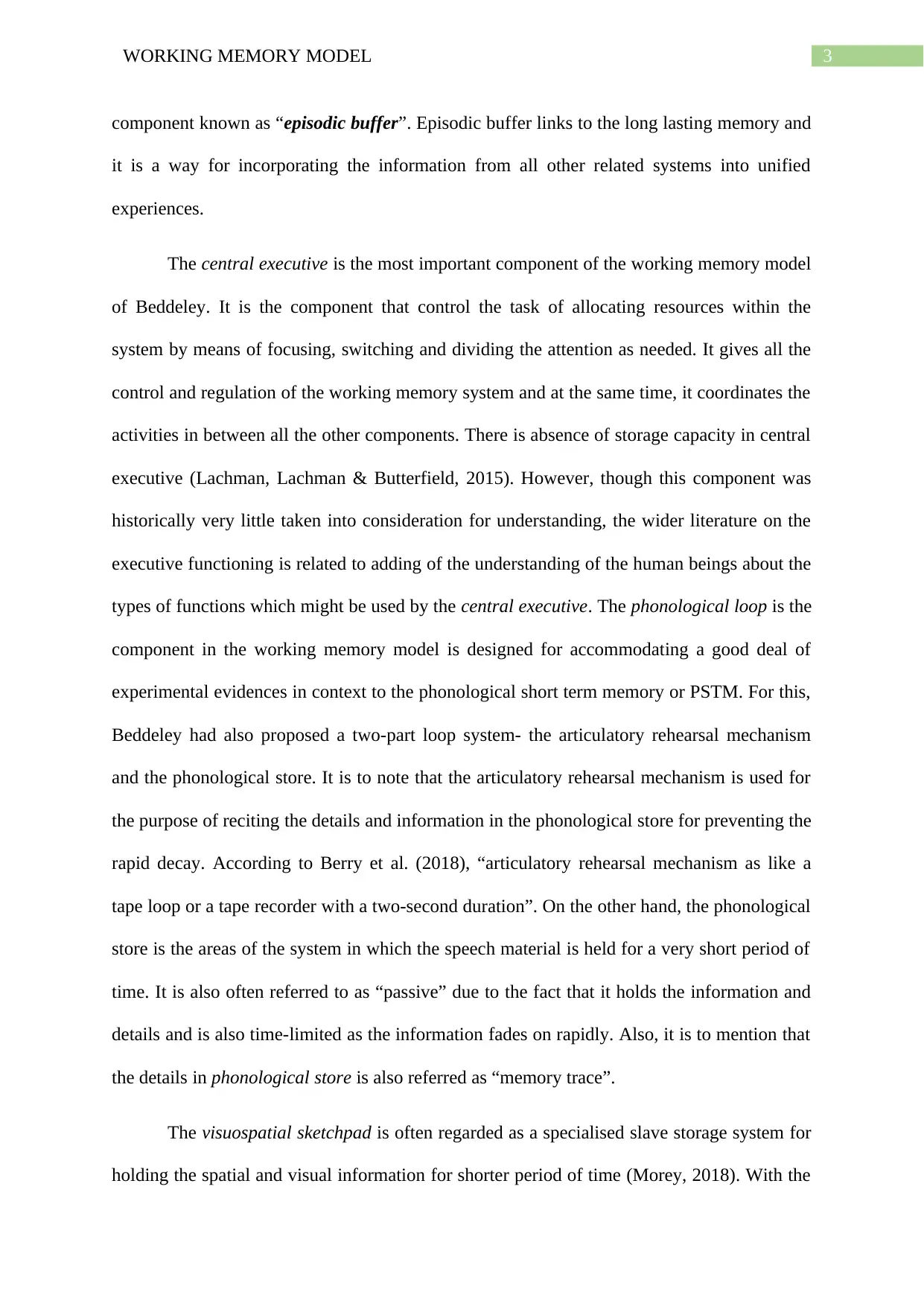
3WORKING MEMORY MODEL
component known as “episodic buffer”. Episodic buffer links to the long lasting memory and
it is a way for incorporating the information from all other related systems into unified
experiences.
The central executive is the most important component of the working memory model
of Beddeley. It is the component that control the task of allocating resources within the
system by means of focusing, switching and dividing the attention as needed. It gives all the
control and regulation of the working memory system and at the same time, it coordinates the
activities in between all the other components. There is absence of storage capacity in central
executive (Lachman, Lachman & Butterfield, 2015). However, though this component was
historically very little taken into consideration for understanding, the wider literature on the
executive functioning is related to adding of the understanding of the human beings about the
types of functions which might be used by the central executive. The phonological loop is the
component in the working memory model is designed for accommodating a good deal of
experimental evidences in context to the phonological short term memory or PSTM. For this,
Beddeley had also proposed a two-part loop system- the articulatory rehearsal mechanism
and the phonological store. It is to note that the articulatory rehearsal mechanism is used for
the purpose of reciting the details and information in the phonological store for preventing the
rapid decay. According to Berry et al. (2018), “articulatory rehearsal mechanism as like a
tape loop or a tape recorder with a two-second duration”. On the other hand, the phonological
store is the areas of the system in which the speech material is held for a very short period of
time. It is also often referred to as “passive” due to the fact that it holds the information and
details and is also time-limited as the information fades on rapidly. Also, it is to mention that
the details in phonological store is also referred as “memory trace”.
The visuospatial sketchpad is often regarded as a specialised slave storage system for
holding the spatial and visual information for shorter period of time (Morey, 2018). With the
component known as “episodic buffer”. Episodic buffer links to the long lasting memory and
it is a way for incorporating the information from all other related systems into unified
experiences.
The central executive is the most important component of the working memory model
of Beddeley. It is the component that control the task of allocating resources within the
system by means of focusing, switching and dividing the attention as needed. It gives all the
control and regulation of the working memory system and at the same time, it coordinates the
activities in between all the other components. There is absence of storage capacity in central
executive (Lachman, Lachman & Butterfield, 2015). However, though this component was
historically very little taken into consideration for understanding, the wider literature on the
executive functioning is related to adding of the understanding of the human beings about the
types of functions which might be used by the central executive. The phonological loop is the
component in the working memory model is designed for accommodating a good deal of
experimental evidences in context to the phonological short term memory or PSTM. For this,
Beddeley had also proposed a two-part loop system- the articulatory rehearsal mechanism
and the phonological store. It is to note that the articulatory rehearsal mechanism is used for
the purpose of reciting the details and information in the phonological store for preventing the
rapid decay. According to Berry et al. (2018), “articulatory rehearsal mechanism as like a
tape loop or a tape recorder with a two-second duration”. On the other hand, the phonological
store is the areas of the system in which the speech material is held for a very short period of
time. It is also often referred to as “passive” due to the fact that it holds the information and
details and is also time-limited as the information fades on rapidly. Also, it is to mention that
the details in phonological store is also referred as “memory trace”.
The visuospatial sketchpad is often regarded as a specialised slave storage system for
holding the spatial and visual information for shorter period of time (Morey, 2018). With the
Paraphrase This Document
Need a fresh take? Get an instant paraphrase of this document with our AI Paraphraser
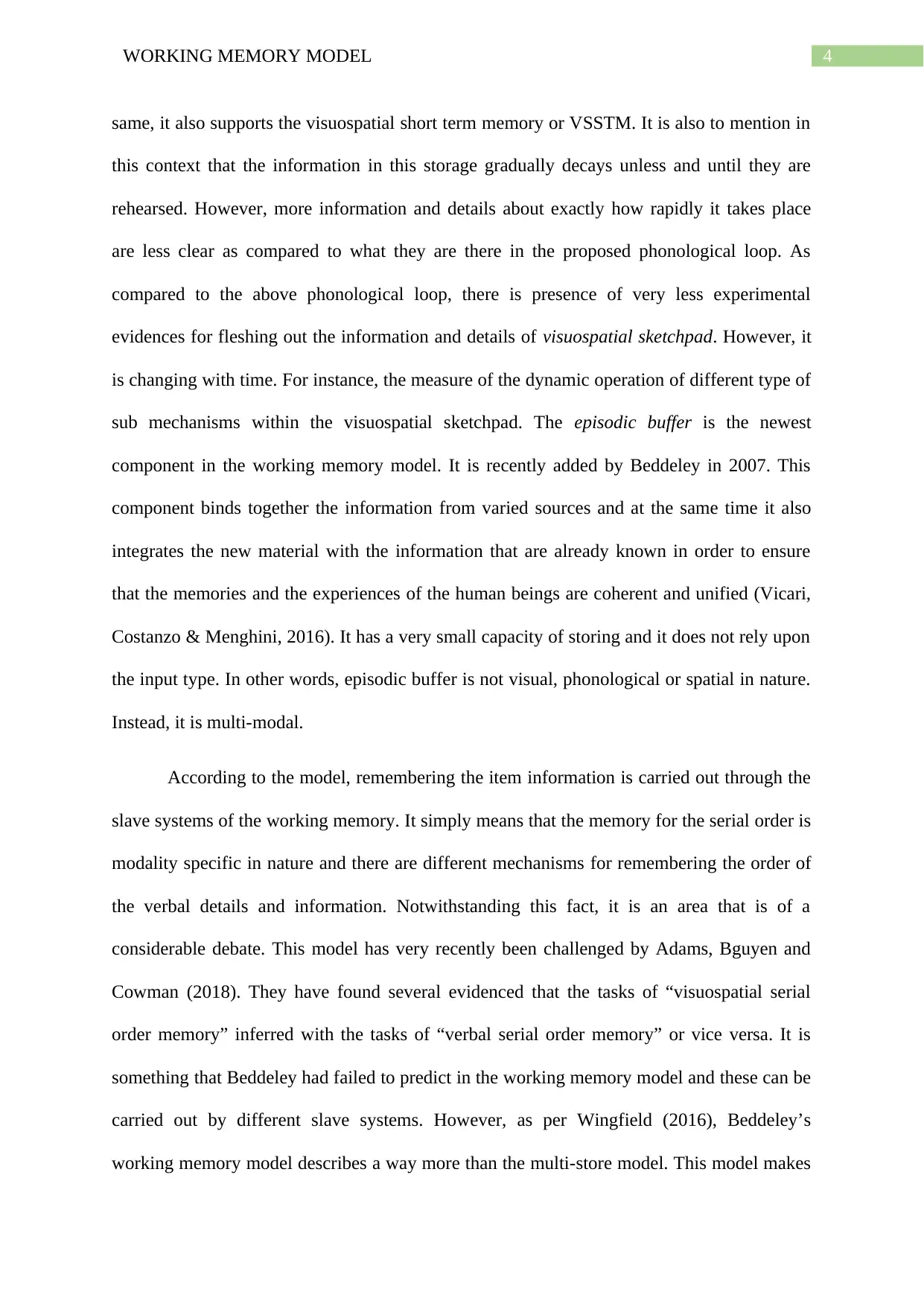
4WORKING MEMORY MODEL
same, it also supports the visuospatial short term memory or VSSTM. It is also to mention in
this context that the information in this storage gradually decays unless and until they are
rehearsed. However, more information and details about exactly how rapidly it takes place
are less clear as compared to what they are there in the proposed phonological loop. As
compared to the above phonological loop, there is presence of very less experimental
evidences for fleshing out the information and details of visuospatial sketchpad. However, it
is changing with time. For instance, the measure of the dynamic operation of different type of
sub mechanisms within the visuospatial sketchpad. The episodic buffer is the newest
component in the working memory model. It is recently added by Beddeley in 2007. This
component binds together the information from varied sources and at the same time it also
integrates the new material with the information that are already known in order to ensure
that the memories and the experiences of the human beings are coherent and unified (Vicari,
Costanzo & Menghini, 2016). It has a very small capacity of storing and it does not rely upon
the input type. In other words, episodic buffer is not visual, phonological or spatial in nature.
Instead, it is multi-modal.
According to the model, remembering the item information is carried out through the
slave systems of the working memory. It simply means that the memory for the serial order is
modality specific in nature and there are different mechanisms for remembering the order of
the verbal details and information. Notwithstanding this fact, it is an area that is of a
considerable debate. This model has very recently been challenged by Adams, Bguyen and
Cowman (2018). They have found several evidenced that the tasks of “visuospatial serial
order memory” inferred with the tasks of “verbal serial order memory” or vice versa. It is
something that Beddeley had failed to predict in the working memory model and these can be
carried out by different slave systems. However, as per Wingfield (2016), Beddeley’s
working memory model describes a way more than the multi-store model. This model makes
same, it also supports the visuospatial short term memory or VSSTM. It is also to mention in
this context that the information in this storage gradually decays unless and until they are
rehearsed. However, more information and details about exactly how rapidly it takes place
are less clear as compared to what they are there in the proposed phonological loop. As
compared to the above phonological loop, there is presence of very less experimental
evidences for fleshing out the information and details of visuospatial sketchpad. However, it
is changing with time. For instance, the measure of the dynamic operation of different type of
sub mechanisms within the visuospatial sketchpad. The episodic buffer is the newest
component in the working memory model. It is recently added by Beddeley in 2007. This
component binds together the information from varied sources and at the same time it also
integrates the new material with the information that are already known in order to ensure
that the memories and the experiences of the human beings are coherent and unified (Vicari,
Costanzo & Menghini, 2016). It has a very small capacity of storing and it does not rely upon
the input type. In other words, episodic buffer is not visual, phonological or spatial in nature.
Instead, it is multi-modal.
According to the model, remembering the item information is carried out through the
slave systems of the working memory. It simply means that the memory for the serial order is
modality specific in nature and there are different mechanisms for remembering the order of
the verbal details and information. Notwithstanding this fact, it is an area that is of a
considerable debate. This model has very recently been challenged by Adams, Bguyen and
Cowman (2018). They have found several evidenced that the tasks of “visuospatial serial
order memory” inferred with the tasks of “verbal serial order memory” or vice versa. It is
something that Beddeley had failed to predict in the working memory model and these can be
carried out by different slave systems. However, as per Wingfield (2016), Beddeley’s
working memory model describes a way more than the multi-store model. This model makes
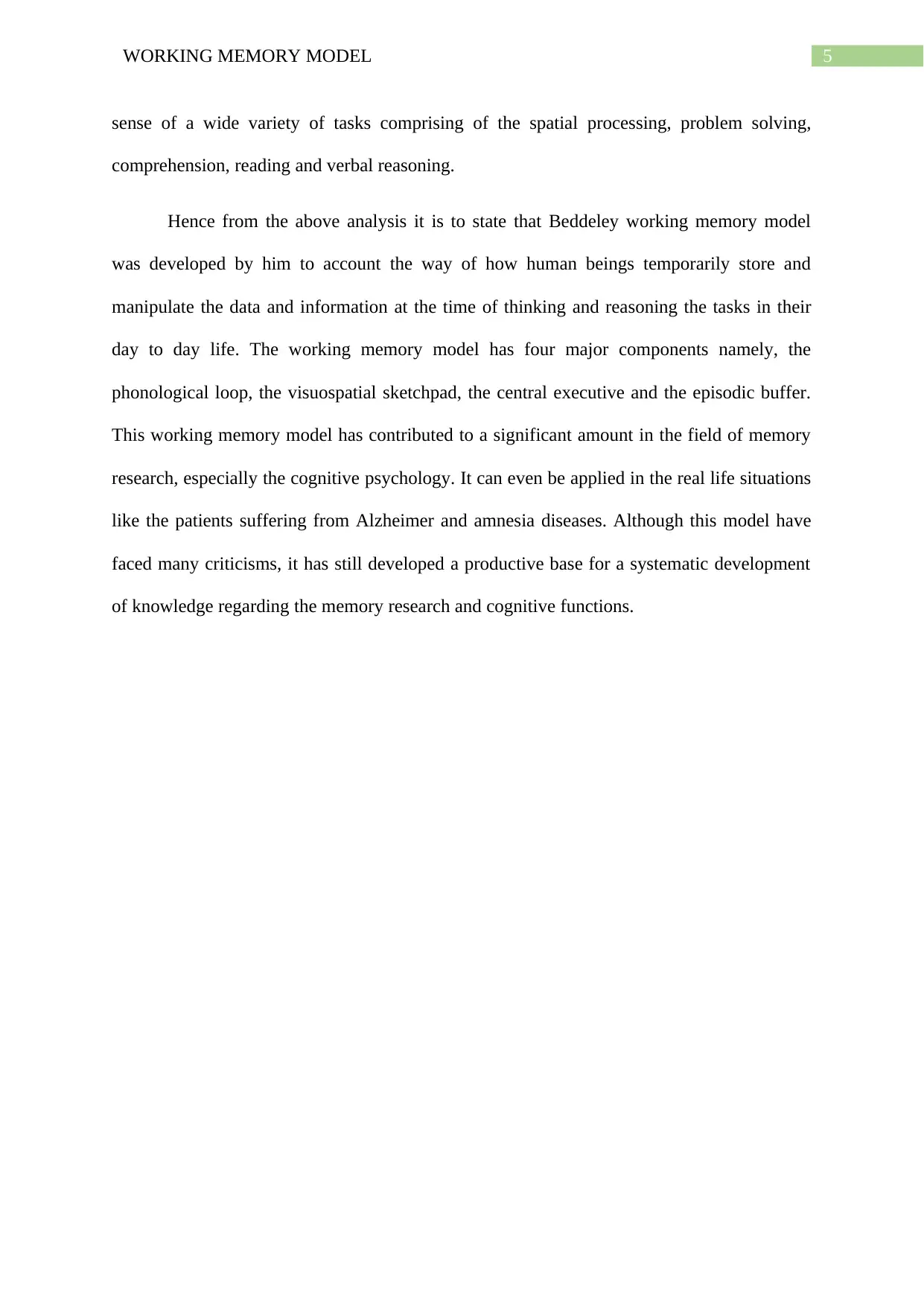
5WORKING MEMORY MODEL
sense of a wide variety of tasks comprising of the spatial processing, problem solving,
comprehension, reading and verbal reasoning.
Hence from the above analysis it is to state that Beddeley working memory model
was developed by him to account the way of how human beings temporarily store and
manipulate the data and information at the time of thinking and reasoning the tasks in their
day to day life. The working memory model has four major components namely, the
phonological loop, the visuospatial sketchpad, the central executive and the episodic buffer.
This working memory model has contributed to a significant amount in the field of memory
research, especially the cognitive psychology. It can even be applied in the real life situations
like the patients suffering from Alzheimer and amnesia diseases. Although this model have
faced many criticisms, it has still developed a productive base for a systematic development
of knowledge regarding the memory research and cognitive functions.
sense of a wide variety of tasks comprising of the spatial processing, problem solving,
comprehension, reading and verbal reasoning.
Hence from the above analysis it is to state that Beddeley working memory model
was developed by him to account the way of how human beings temporarily store and
manipulate the data and information at the time of thinking and reasoning the tasks in their
day to day life. The working memory model has four major components namely, the
phonological loop, the visuospatial sketchpad, the central executive and the episodic buffer.
This working memory model has contributed to a significant amount in the field of memory
research, especially the cognitive psychology. It can even be applied in the real life situations
like the patients suffering from Alzheimer and amnesia diseases. Although this model have
faced many criticisms, it has still developed a productive base for a systematic development
of knowledge regarding the memory research and cognitive functions.
⊘ This is a preview!⊘
Do you want full access?
Subscribe today to unlock all pages.

Trusted by 1+ million students worldwide
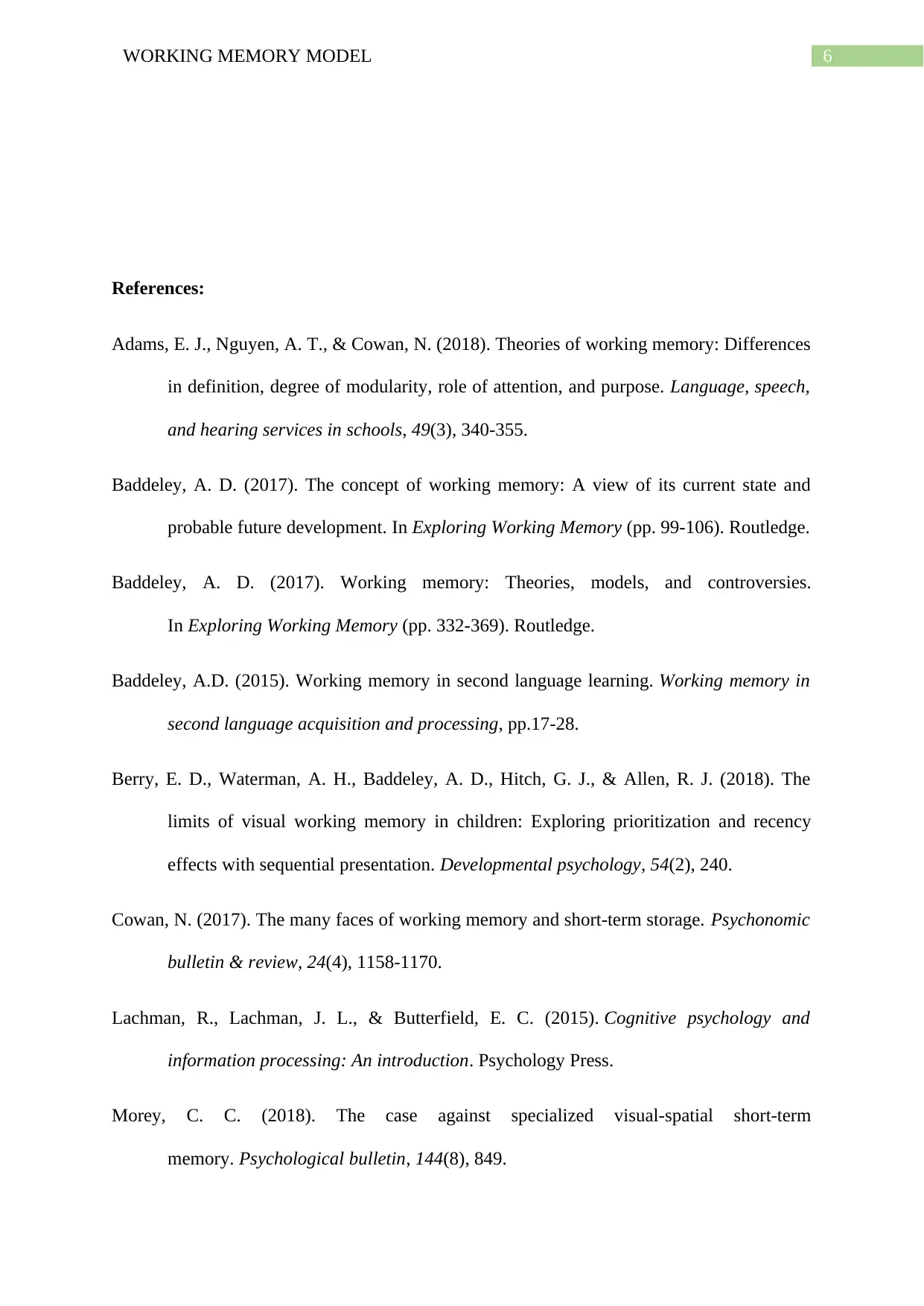
6WORKING MEMORY MODEL
References:
Adams, E. J., Nguyen, A. T., & Cowan, N. (2018). Theories of working memory: Differences
in definition, degree of modularity, role of attention, and purpose. Language, speech,
and hearing services in schools, 49(3), 340-355.
Baddeley, A. D. (2017). The concept of working memory: A view of its current state and
probable future development. In Exploring Working Memory (pp. 99-106). Routledge.
Baddeley, A. D. (2017). Working memory: Theories, models, and controversies.
In Exploring Working Memory (pp. 332-369). Routledge.
Baddeley, A.D. (2015). Working memory in second language learning. Working memory in
second language acquisition and processing, pp.17-28.
Berry, E. D., Waterman, A. H., Baddeley, A. D., Hitch, G. J., & Allen, R. J. (2018). The
limits of visual working memory in children: Exploring prioritization and recency
effects with sequential presentation. Developmental psychology, 54(2), 240.
Cowan, N. (2017). The many faces of working memory and short-term storage. Psychonomic
bulletin & review, 24(4), 1158-1170.
Lachman, R., Lachman, J. L., & Butterfield, E. C. (2015). Cognitive psychology and
information processing: An introduction. Psychology Press.
Morey, C. C. (2018). The case against specialized visual-spatial short-term
memory. Psychological bulletin, 144(8), 849.
References:
Adams, E. J., Nguyen, A. T., & Cowan, N. (2018). Theories of working memory: Differences
in definition, degree of modularity, role of attention, and purpose. Language, speech,
and hearing services in schools, 49(3), 340-355.
Baddeley, A. D. (2017). The concept of working memory: A view of its current state and
probable future development. In Exploring Working Memory (pp. 99-106). Routledge.
Baddeley, A. D. (2017). Working memory: Theories, models, and controversies.
In Exploring Working Memory (pp. 332-369). Routledge.
Baddeley, A.D. (2015). Working memory in second language learning. Working memory in
second language acquisition and processing, pp.17-28.
Berry, E. D., Waterman, A. H., Baddeley, A. D., Hitch, G. J., & Allen, R. J. (2018). The
limits of visual working memory in children: Exploring prioritization and recency
effects with sequential presentation. Developmental psychology, 54(2), 240.
Cowan, N. (2017). The many faces of working memory and short-term storage. Psychonomic
bulletin & review, 24(4), 1158-1170.
Lachman, R., Lachman, J. L., & Butterfield, E. C. (2015). Cognitive psychology and
information processing: An introduction. Psychology Press.
Morey, C. C. (2018). The case against specialized visual-spatial short-term
memory. Psychological bulletin, 144(8), 849.
Paraphrase This Document
Need a fresh take? Get an instant paraphrase of this document with our AI Paraphraser
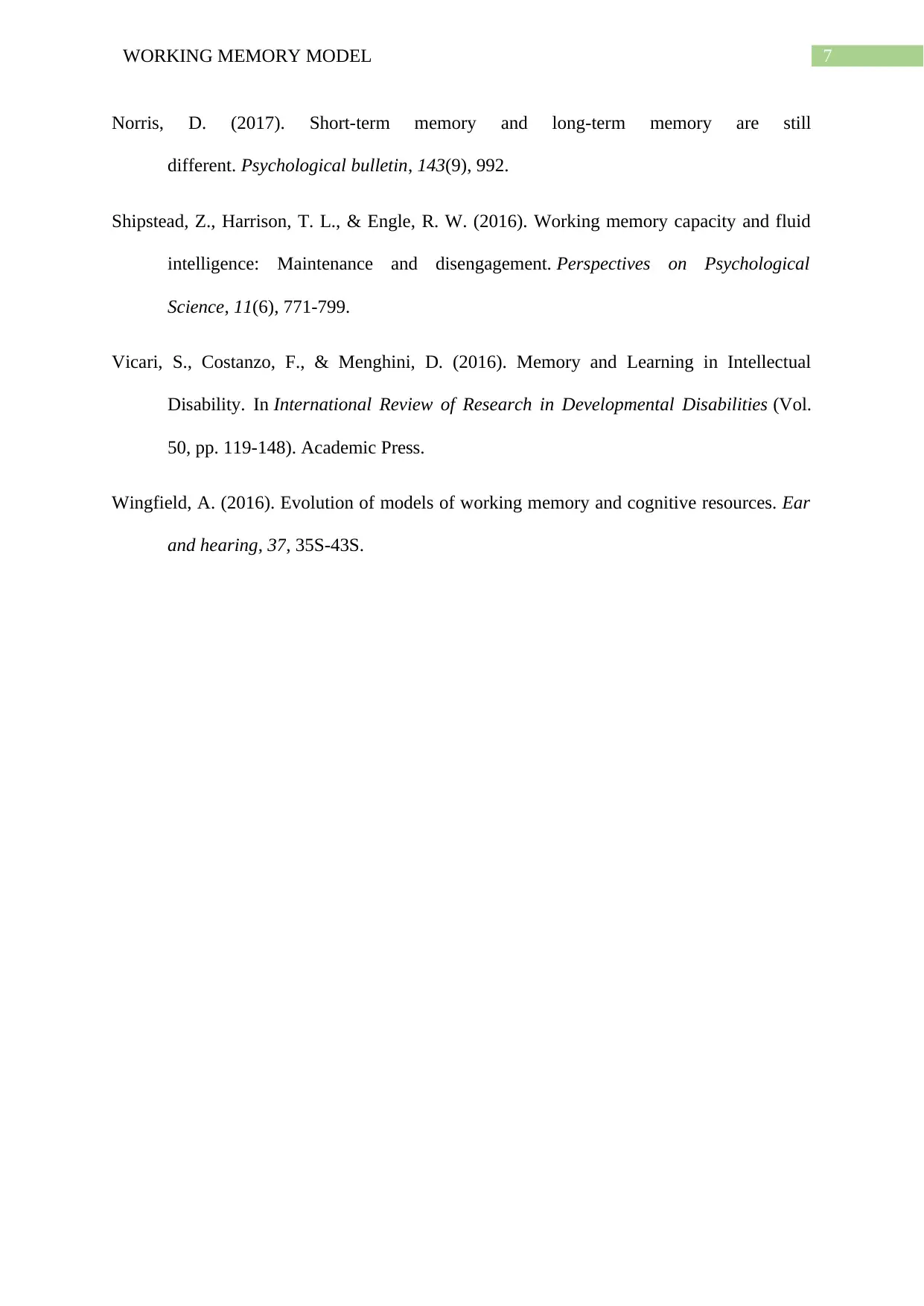
7WORKING MEMORY MODEL
Norris, D. (2017). Short-term memory and long-term memory are still
different. Psychological bulletin, 143(9), 992.
Shipstead, Z., Harrison, T. L., & Engle, R. W. (2016). Working memory capacity and fluid
intelligence: Maintenance and disengagement. Perspectives on Psychological
Science, 11(6), 771-799.
Vicari, S., Costanzo, F., & Menghini, D. (2016). Memory and Learning in Intellectual
Disability. In International Review of Research in Developmental Disabilities (Vol.
50, pp. 119-148). Academic Press.
Wingfield, A. (2016). Evolution of models of working memory and cognitive resources. Ear
and hearing, 37, 35S-43S.
Norris, D. (2017). Short-term memory and long-term memory are still
different. Psychological bulletin, 143(9), 992.
Shipstead, Z., Harrison, T. L., & Engle, R. W. (2016). Working memory capacity and fluid
intelligence: Maintenance and disengagement. Perspectives on Psychological
Science, 11(6), 771-799.
Vicari, S., Costanzo, F., & Menghini, D. (2016). Memory and Learning in Intellectual
Disability. In International Review of Research in Developmental Disabilities (Vol.
50, pp. 119-148). Academic Press.
Wingfield, A. (2016). Evolution of models of working memory and cognitive resources. Ear
and hearing, 37, 35S-43S.
1 out of 8
Related Documents
Your All-in-One AI-Powered Toolkit for Academic Success.
+13062052269
info@desklib.com
Available 24*7 on WhatsApp / Email
![[object Object]](/_next/static/media/star-bottom.7253800d.svg)
Unlock your academic potential
Copyright © 2020–2025 A2Z Services. All Rights Reserved. Developed and managed by ZUCOL.





